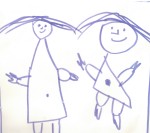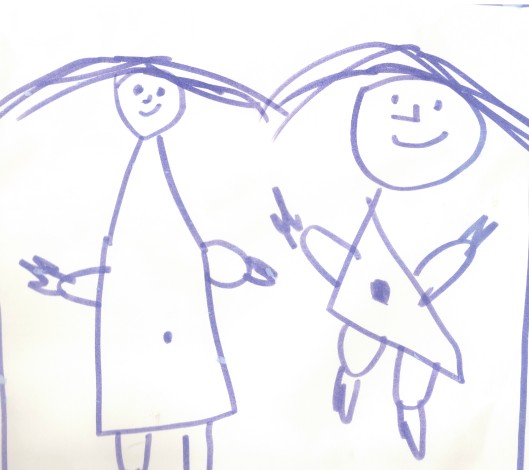
 Dessin d'enfant, coll.privée.Ever since Freud, psychoanalysis has taken an interest in the psychic life of Children. First considered a minor practice, psychoanalysis with children reached its full dimension in the 1970s.
Dessin d'enfant, coll.privée.Ever since Freud, psychoanalysis has taken an interest in the psychic life of Children. First considered a minor practice, psychoanalysis with children reached its full dimension in the 1970s.
In Europe, as from the 1910s, the psychoanalytic field opens on the question of psychoanalysis with children. The relationship held by psychoanalysis with the infantile is first filtered through the treatment of an adult: the famous case of young Hans is the psychoanalytical study of a child phobia by his own father, Herbert Graf, supervised by Freud. Meanwhile, one aspect of Freud’s biography remains overlooked in the history of psychoanalysis: in 1886, Freud spent one month in the paediatric ward of German paediatrician Adolf Baginsky’s polyclinic in Berlin before running the department of nervous diseases at the in Public Institute for Sick Children in Vienna for some ten years. Freud’s paediatric formation may have counted for more than he allows in the origin of psychoanalysis. Freud and his disciples were coincidentally showing a fairly early interest in pedagogy and child education. The psychoanalysts ‘s preoccupations lay essentially with children’s sexual behaviour, linked with the issue of onanism and its impact on the nervous system. This vision gradually progressed towards the treatment of children’s neurosis and symptoms.
To tell the history of child psychoanalysis, long considered a minor discipline, it behoves one to give an account of its pioneers who are women. Hermine Hug-Hellmuth was an Austrian psychoanalyst, among the first to apply the psychoanalytical method to children. In her essay “On the Technique of the Analysis of Children”, presented in 1920, she introduced the educational dimension of play in a child’s treatment. She is also known for her tragic death strangled by her 18 years old nephew whose education she had undertaken and whom she had been analysing.
After being analysed by Freud, the Polish psychologist Eugénie Sokolnicka arrived in France in 1921. She is a major figure in child psychoanalysis and was party to the creation of La Société psychanalytique de Paris. One of its analysts, Sophie Morgenstern, was among the first to practice psychoanalysis with children in France. She met Georges Heuyer, French paedo-psychiatry’s leading light, who hired her in the Clinic of Paediatric Neuropsychiatry he ran. As of the mid 1920s many paediatric neuropsychiatric or medical social consultations got organised in paediatrics departments and outpatient clinics. Morgentsern trained several generations of analysts, such as Pierre Mâle or even Françoise Marette, later Dolto, whom she introduced to the children’s drawing approach. Her paper “Un cas de mutisme psychogène”, published in 1927 theorises the use of free drawing towards grasping a small boy’s conflicts. Her psychoanalytic work with children lasted until 1940 when she committed suicide as the Nazi troops entered Paris.
The history of child psychoanalysis is also marked by the rivalry between two psychoanalysts: Anna Freud and Melanie Klein. Already in Vienna, Anna Freud had developed her practice and her interest in child psychoanalysis within a “Kinderseminar ” which she had set up with other analysts such as August Aichorn, Margaret Lalher and also René Spitz. Anna Freud’s work is based on her research and her clinical practice in the framework of the Hampstead Clinic which she created in 1952. Established in London since 1926, Melanie Klein came up with diverging approaches, devising new concepts and a framework specific to child psychoanalysis. As with Donald Winnicott after her, the emphasis is on the relationship between mother and child and a very special place is granted to play. The quarrel between the two women revolves around the framework of child psychoanalysis, its educational purpose and the key question of transference. Anna Freud holds for a practice with a pedagogic input whereas Klein strives to interpret children’s dreams and fantasies.
Child psychoanalysis was still a sub-specialism when, under Georges Heuyer’s aegis, in 1937, the First International Congress of Child Psychiatry afforded the discipline a minimal space. Not before the end of WWII would child and adolescent psychoanalysis be institutionalised in France. In 1946, the first CPP (Centre for psycho pedagogical support) intended for children and adolescents opened within the lycée Claude Bernard in Paris. Others would follow notably in Toulouse, driven by Juliette Favez-Boutonnier. In close connection with the psychoanalytic movement, these centres would become the CMPPs (Centre for medical and psycho pedagogical support) managed by non-profit and recognised public utility associations. They are the first places where child education is taken into account with psycho-pedagogists, and child psychic disorders with psychoanalysts prior to the setting up of the 1970s “secteur infanto-juvénile” (Children and young people’s mental health services). Thereafter psychoanalysis becomes the chief reference in paedo-psychiatry until it is called into question in the 1990s.
Read more in the dictionary :Asperger - Dreamcatcher - Social paediatrics
Read the paper in French : Psychanalyse de l'enfant
References :
Annick Ohayon, « Les premiers moments de la psychanalyse de l’enfant en France dans les années 1920 et 1930 », Revue d’histoire de l’enfance « irrégulière », n°18, 2016, p.233-251.
Nicole Catheline, L’enfant et la médecine. Une histoire de la pédopsychiatrie (XIXe-XXe siècle), L’Harmattan, 2021.
To quote this paper : , Camille Monduit de Caussade, “Child Psychoanalysis” in Hervé Guillemain (ed.), DicoPolHiS, Le Mans Université, 2024.